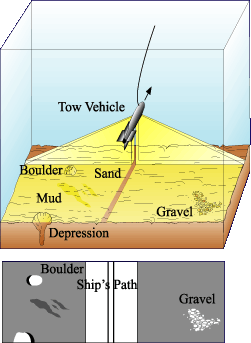Side-scan sonar
|
|
Side-scan sonar is a technique of archaeological survey in nautical archaeology. It is not only used for nautical archaeology but has application in mapping the morphology of the seafloor. In conjunction with seafloor samples it is able to provide an understanding of the surface geology of the seabed. Side scan sonar imagery is also a commonly used tool to detect debris items and other obstructions on the seafloor that may be hazardous to shipping and seafloor installations by the oil and gas industry. In addition, the status of pipelines and cables on the seafloor can be investigated using side scan sonar. Side scan sonar data is typically acquired along with bathymetric soundings and sub-bottom data which provides a glimpse of the shallow structure of the seabed.
It uses a sonar device that emits pulses down toward the seafloor across a wide angle. It can detect large objects lying on the seafloor that are completely invisible in the murky seawater. The sound frequencies used in side-scan sonar usually range from 100 to 500 kHz; high frequencies yield better resolution but less range.
Side-scan sonar was invented by a German Scientist, Dr. Julius Hagemann, who was brought to the US after WW II and worked at the US Navy Mine Defense Laboratory, Panama City, FL from 1947 until his death in 1964. It is documented in US Patent 4,197,591 which was first disclosed in Aug 1958, but remained classified by the US Navy until it was finally issued in 1980. Side-scan sonar was commercially developed in the 1960s. Important contributors included Harold Edgerton.
External links
- Side Scan Sonar (http://www.abc.se/~pa/mar/sidescan.htm)
- Pictures and description of USGS Benthos SIS-1000 (http://woodshole.er.usgs.gov/operations/sfmapping/towvehicles.htm) sidescan sonar tow vehicle.

